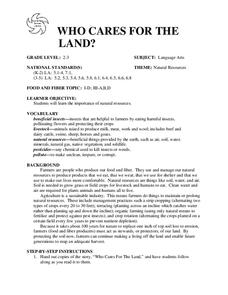Cornell University
Fibers, Dyes, and the Environment
Nanofibers can be made through electrospinning or force spinning in order to reduce the negative impact on the environment. Pupils study the role of fibers and dye on the environment through a series of five hands-on activities. Then,...
Curated OER
Natural Fibers and Textiles
Students sort fibers by identifying the appropriate characteristics of natural fibers. After sorting, students determine the difference between man-made and natural fibers, and play textile bingo.
Curated OER
Natural Fibers/Textiles
Learners identify basic fibers, the characteristics, use and care of each textile. They sort fibers by identifying the appropriate characteristics of natural fibers. In the end, they participate in a textile bingo game.
Curated OER
Clothes on the Grow
Can you grow clothes? Sure, wool, cotton, and Angora are all natural resources used to make textile products. Learners investigate the differences between synthetic and natural fibers, then consider textile processing careers. They watch...
Curated OER
Bird Brilliance!
First graders explore natural resources and search outdoors to find materials to create a bird's nest. In this bird's natural resources lesson, 1st graders listen to a book about birds and reflect on the various things birds use to...
Curated OER
Natural and Synthetic Fibers
Students study written descriptions of what various fibers look like through a microscope and with the naked eye. Then they actually view these fibers through a microscope and sitting on a table. They identify which is which based on...
Curated OER
Natural Dyes From Plants
Students investigate how natural dyes from plants was an expression of Native American cultures. They examine objects dyed from natural sources, conduct Internet research, and create their own dyes using various plant sources.
Curated OER
Fabrics and Polymers
Students explore natural resources by reading a science story in class. In this fibers lesson, students identify and discuss the differences between fibers such as wool, silk, rayon, linen and cotton. Students identify the common uses of...
Howard Hughes Medical Institute
How Do Fibers Form?
The proteins inside a cell determine the shape of the cell. While most red blood cells have a circular shape, those with sickle cell take the shape of a sickle. This change in shape causes multiple issues in the system. Scholars solve...
Curated OER
Fibers
Students examine the difference between natural and synthetic fibers. They correctly match natural and synthetic fibers by playing with fiber game cards. They work as a group to put the fibers into the correct categories.
Curated OER
FACS:Fibers
Students investigate the difference between natural and synthetic fibers. They correctly match natural and synthetic fibers.
Curated OER
WHO CARES FOR THE LAND?
Students explore the importance of natural resources. They are given copies of the story, "Who Cares For The Land," and students follow
along as the teacher reads it. Students identify the key points in the story. (Soil, water and air...
University of Northern Iowa
Clothing
As part of an investigation of the folk traditions of their area, class members research the articles of clothing worn at earlier times, the fibers and materials, and the machinery used to produce these items. In addition, class members...
Curated OER
Horse Sculpture (or animal of choice)
After a discussion on horse in art and a presentation on safety techniques using materials, learners construct a horse sculpture (or other animal of their choice) from sticks and natural fibers.
Curated OER
Nature Inspired Batik T-Shirt
A wonderful product called Batik is the focus of this lesson. High schoolers should love this art lesson, because each shirt will come out differently, and each student puts their original "stamp" on it. One warning: there are a lot of...
Curated OER
Health In Progress - Processed Foods
Students compare and contrast processed foods to unprocessed foods. After exploring the differences, they research the health factors, benefits and concerns in both types of food. Discussions include fats, sweeteners, fiber, vitamins,...
Curated OER
Bugging Out
Students explore how insects behave in their natural habitats and build dioramas to create an Insect World in their classroom. They investigate various insects and the roles they play in the environment. They write creative short...
Curated OER
Interior Design- Textiles
Students investigate natural and synthetic fibers. In this textiles lesson plan, students pass around samples of carpet, drapes and clothing and decide what they are made of. Students use KWL charts to organize information from reading...
Curated OER
Drawing on Kenaf
Young scholars explore kenaf, a tree-free paper. In this environmental issues instructional activity, students draw pictures following a presentation about the origin and "eco-friendly" nature of kenaf.
Curated OER
Discovering Forest Products
Learners identify attributes of natural and manufactured wood products. In this forest products instructional activity, students perform independent research to find an article about forest use or forest products. They spread out samples...
Curated OER
Biology: Plants - The Fiber of Life
Students, in groups, examine and list the varieties of plants and how they relate to man and the environment. They create plant books complete with leaf samples with sketches and information, grow beans in plastic baggies, and role-play...
Curated OER
Worms: Nature's Recyclers
Students explore vermi-composting. In this vermi-composting lesson, students listen to the story Diary of a Worm and discuss the parts of a worm. They create worm bins and add organic food for the worms to recycle.
Global Oneness Project
Rethinking the Fabrics We Wear
What are fibersheds and what what do they have to do with environmental protections? A photo essay and audio recordings about Mimi Luebbermann, and her sheep, cause consumers to reflect on how their clothing choices can support local...
Curated OER
Oil and Gas As A Source of Energy
Students discuss the reasons why oil and gas are the United States' main source of energy. In groups, they use the internet to research how the resources are formed and the amount of consumption by the United States. They choose books...

























